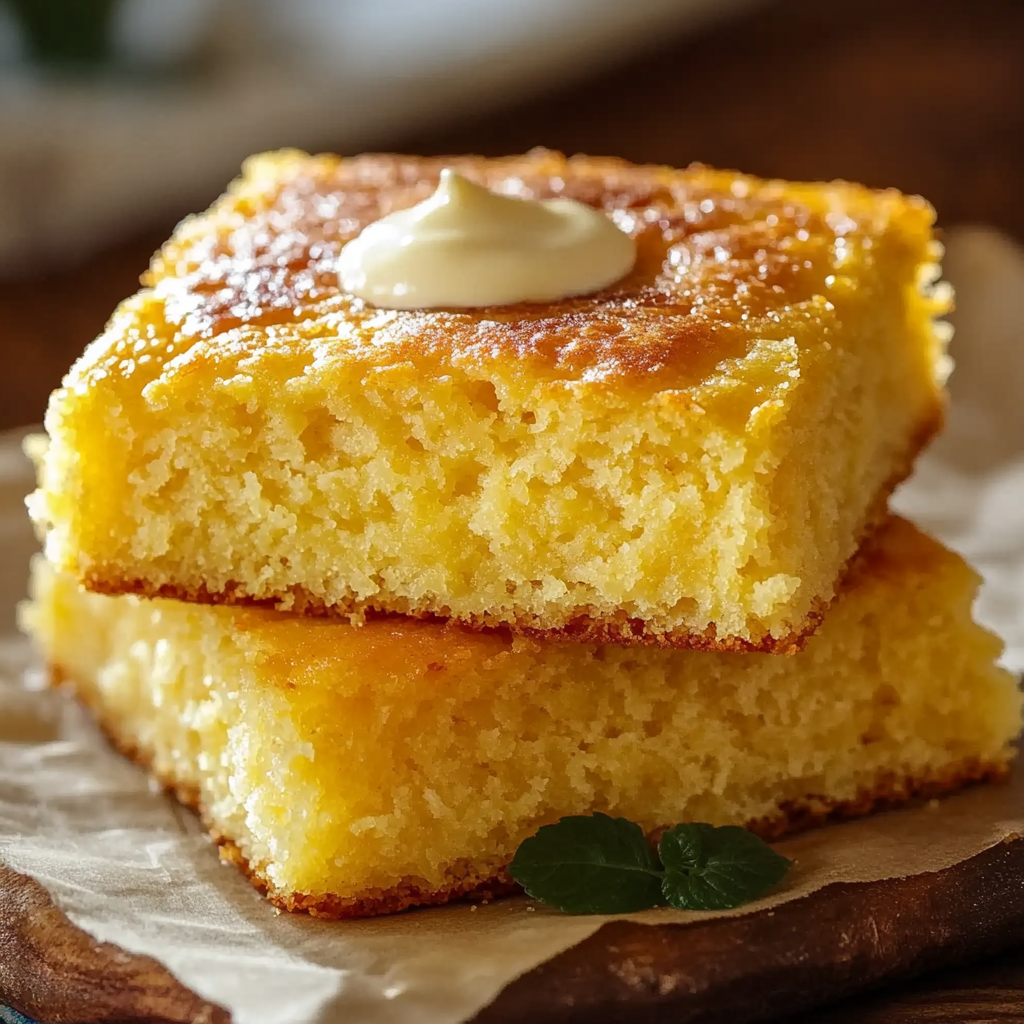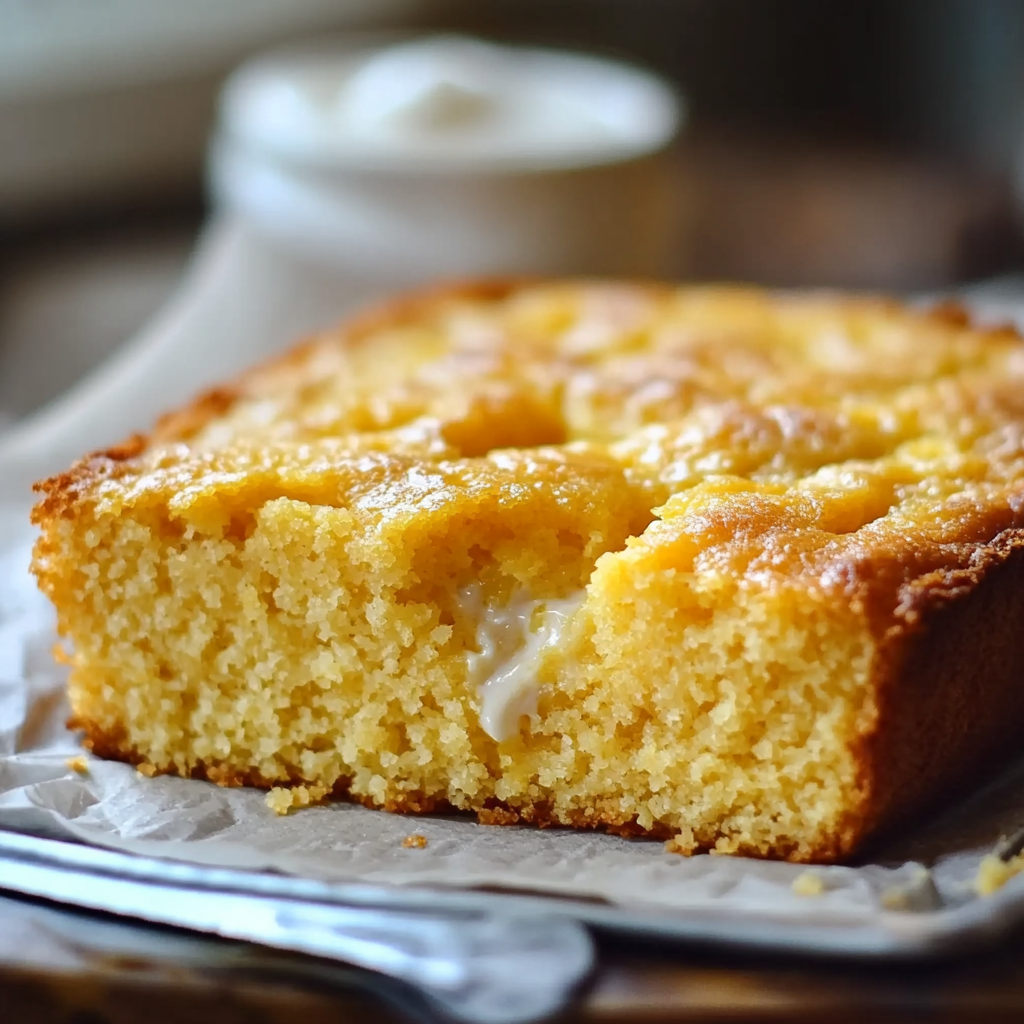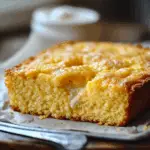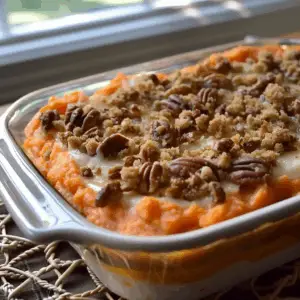There’s a reason cornbread holds a special place in American comfort food—its buttery crumb, warm golden color, and slight sweetness make it the perfect companion to everything from hearty stews to backyard barbecue. But if you’ve ever had a dry, crumbly slice, you know how disappointing poorly made cornbread can be. The secret to avoiding that common pitfall lies in two game-changing ingredients: sour cream and cream corn.
These two additions revolutionize basic cornbread by introducing unbeatable moisture, flavor, and a rich, creamy texture that simply can’t be achieved with standard recipes. This recipe, inspired by traditional Amish cooking, delivers a consistently moist, tender loaf every single time. Amish recipes are known for their simplicity and authenticity—using accessible ingredients in just the right proportions. According to Wikipedia’s entry on Amish cuisine, Amish food emphasizes heartiness and minimalism, which makes this version of cream cornbread a true staple in homes looking for dependable, delicious results.
If you’ve ever wondered how to make cornbread that doesn’t fall apart or dry out, this guide is for you. Whether served with a bowl of chili or sliced and slathered with honey butter, this Amish cream cornbread recipe—with the magic combo of sour cream and creamed corn—delivers a golden, fluffy loaf that tastes like tradition with a twist.

Why Moisture Matters in Cornbread
One of the biggest challenges in making cornbread is achieving the perfect texture. Too often, home bakers end up with a dry, grainy, or crumbly result that lacks the rich tenderness the dish is known for. Moisture isn’t just a preference—it’s essential to the success of any good cornbread recipe.
When cornmeal is the star ingredient, it’s naturally coarse and dry by nature. Without adequate moisture, this can lead to a dense or gritty texture. Adding ingredients like sour cream and creamed corn counterbalances that dryness. Sour cream, in particular, is loaded with fat and acidity, which contributes to both a moist crumb and a slight tang that enhances the overall flavor profile. According to Wikipedia’s article on sour cream, its high fat content helps to tenderize baked goods by interfering with gluten development, resulting in a softer, more delicate structure.
Creamed corn, on the other hand, adds a sweet depth and natural creaminess without thinning the batter too much. This makes it a perfect complement in achieving a moist texture while preserving the classic cornbread flavor. Pinterest boards like this one on creamed corn recipe ideas offer dozens of variations that show just how versatile and effective this ingredient can be in baked dishes.
Here’s why moisture is a non-negotiable factor in cornbread success:
-
Improved texture: A moist crumb ensures the bread holds together yet remains soft.
-
Better flavor integration: Fat-based ingredients like sour cream carry and enhance flavors more effectively.
-
Longer freshness: Moisture keeps the cornbread from drying out too quickly, making leftovers enjoyable.
Understanding the role of moisture and how to harness it with the right ingredients is what elevates a basic cornbread to a memorable, crowd-pleasing dish.
Amish Cream Cornbread: What Makes It Special
Amish cream cornbread stands out not only for its incredibly moist texture, but also for its deep connection to the traditions of Amish cuisine. This style of cooking is centered around simplicity, quality, and comfort—values that are perfectly embodied in this recipe. With a focus on pantry staples and no-frills techniques, Amish recipes have earned their place in American kitchens for their reliability and wholesome results.
The Amish approach to baking emphasizes what you have on hand, and ingredients like cornmeal, sour cream, and creamed corn are often used to create rich, filling breads without needing complex methods. According to Wikipedia’s page on Amish cuisine, the Amish rely on time-tested, resourceful methods passed down through generations. This cornbread, often referred to as “Amish cream cornbread,” is no different—it’s hearty, forgiving, and designed to serve the whole family.
What makes this specific recipe special is the use of both sour cream and a touch of oil alongside melted butter. This fat combination maximizes softness while preserving a buttery richness. The granulated sugar offers just the right hint of sweetness without overwhelming the classic cornbread flavor, striking the perfect balance between Southern-style cornbread and the more savory Northern versions. Pinterest boards like cast iron baking tips show how versatile and adaptable this kind of baking can be, whether using a skillet, muffin tin, or baking dish.
Key reasons this recipe is special:
-
Traditionally rooted: Inspired by Amish principles of simplicity and family-focused meals.
-
Perfectly balanced flavor: Slightly sweet, slightly savory, incredibly moist.
-
Accessible ingredients: Everything is likely already in your pantry or easy to find.
-
Versatile results: Pairs with a wide range of meals, from chili to fried chicken.
The beauty of Amish cream cornbread is that it doesn’t need to be complicated to be exceptional—it just needs the right ingredients and a little care in preparation.
Key Ingredients and Their Roles
A great cornbread starts with understanding the function of each ingredient. Each component in this cream cornbread recipe contributes to its flavor, moisture, and structure. When you combine sour cream and creamed corn with traditional baking elements, the result is a superior loaf that’s both tender and deeply satisfying.
1. Cornmeal vs. All-Purpose Flour
-
Cornmeal provides the classic gritty texture and earthy corn flavor that defines cornbread. It’s essential for authenticity.
-
All-purpose flour softens that texture, creating a tender crumb. The 1:1 ratio in this recipe strikes the perfect balance.
-
For more on the characteristics of different cornmeal types, see Wikipedia’s page on cornmeal.
2. Sour Cream
-
Acts as the moisture powerhouse in this recipe.
-
High-fat content keeps the crumb soft, while the tang adds flavor complexity.
-
It also contributes acidity, which works with baking soda to boost leavening.
-
If you’re out of sour cream, Wikipedia offers substitution options such as buttermilk or yogurt.
3. Creamed Corn
-
Not always included in standard cornbread recipes, but it gives this version its signature moisture and natural sweetness.
-
Whole kernels add a subtle bite, while the creamy base binds the batter.
-
Find more ideas for using creamed corn on Pinterest.
4. Butter & Vegetable Oil
-
Using both fat types ensures the bread is flavorful and moist.
-
Melted butter adds richness, while oil adds tenderness and prevents drying out.
-
This combo is common in many moist baking recipes, as seen in moist baking tips on Pinterest.
5. Eggs & Milk
-
Eggs provide structure and help the bread rise. They also trap air during mixing for a fluffier result.
-
Milk thins the batter just enough to make it pourable without being runny.
6. Leavening Agents: Baking Powder and Baking Soda
-
The dual use ensures lift and a light crumb.
-
The baking soda reacts with sour cream’s acidity, while baking powder provides additional leavening.
-
Learn more about their differences on Wikipedia’s baking soda page.
7. Sugar and Salt
-
Sugar sweetens and enhances flavor without making the cornbread a dessert.
-
Salt balances the sweetness and intensifies the savory elements.
Each of these ingredients has been chosen with intention. When combined, they create a cornbread that’s flavorful, moist, and structured just right.
Step-by-Step Recipe Guide
Making this cream cornbread with sour cream is a straightforward process, but success lies in the details. Here’s how to nail it every time:
1. Preheat and Prep
-
Preheat your oven to 400°F (200°C).
-
Grease an 8×8-inch baking dish or line it with parchment paper for easy release.
-
You can also use a cast iron skillet for a crispier edge (explore more cast iron baking tips here).
2. Combine Dry Ingredients
-
In a large mixing bowl, whisk together:
-
1 cup cornmeal
-
1 cup all-purpose flour
-
¼ cup sugar
-
1 tbsp baking powder
-
½ tsp baking soda
-
½ tsp salt
-
-
Mixing these separately ensures even distribution and prevents lumps.
3. Mix Wet Ingredients
-
In another bowl, whisk:
-
2 large eggs
-
1 cup sour cream
-
½ cup milk
-
¼ cup melted butter
-
2 tbsp vegetable oil
-
4. Combine and Mix
-
Slowly pour wet ingredients into the dry mix.
-
Stir just until combined—do not overmix, or the texture will toughen.
5. Bake
-
Pour batter into the prepared dish and smooth the top.
-
Bake for 20–25 minutes until golden brown and a toothpick inserted in the center comes out clean.
-
Let cool slightly before slicing and serving.
Want more traditional techniques like this? Read up on the history of cornbread to see how it’s evolved regionally.

Customizing Your Cornbread
While this recipe is nearly perfect as-is, cornbread is incredibly flexible. Here are a few delicious ways to make it your own:
-
Add cheese: Mix in shredded sharp cheddar or pepper jack.
-
Spice it up: Diced jalapeños or chili flakes add a spicy kick.
-
Make it sweet: Add a drizzle of honey to the batter or top with maple syrup before serving.
-
Make it gluten-free: Substitute a 1:1 gluten-free flour blend for the all-purpose flour.
-
Cut the sugar: Reduce the sugar if you prefer savory cornbread, popular in Southern-style versions.
For visual ideas, check out buttermilk substitutes in baking that can also work with sour cream swaps.
Serving Suggestions
This moist cream cornbread is extremely versatile at the dinner table. It’s best served:
-
Warm, straight from the oven
-
With chili, stews, or BBQ ribs
-
As a breakfast item with honey butter
-
Alongside fried chicken or grilled meats
Top with flavored butters or a dollop of sour cream for extra flair.
Storage and Reheating Tips
Proper storage helps retain the moisture and flavor of your cornbread:
-
Refrigerate: Store leftovers in an airtight container for up to 5 days.
-
Freeze: Wrap tightly in foil and freeze for up to 3 months.
-
Reheat: Warm in the oven at 300°F for 10 minutes or microwave individual pieces with a damp paper towel to prevent drying.
Make it ahead by baking the day before and warming just before serving.
Cornbread Variations: Beyond the Basics
This recipe is a great base, but there are many creative ways to switch it up:
-
Skillet cornbread: Bake in a preheated cast iron pan for crispy edges.
-
Cornbread muffins: Use a muffin tin for individual portions.
-
Sweet cornbread: Add more sugar, a bit of vanilla, or use cake flour for a softer bite.
-
Savory twist: Add herbs like rosemary or thyme.
For ideas, explore Pinterest’s collection of moist baking tips to adapt the base recipe to your style.
Common Mistakes and How to Avoid Them
Cornbread may seem simple, but a few common errors can ruin your bake. Here’s how to avoid them:
-
Overmixing: Mix just until the ingredients are combined to avoid a dense loaf.
-
Wrong cornmeal type: Use medium grind for best texture—not coarse or too fine.
-
Dry pan: Always grease or line your baking dish to avoid sticking.
-
Overbaking: Start checking at 20 minutes. The top should be golden but not hard.
Want to know more about baking science? Compare baking soda and baking powder to understand how they interact in recipes.

FAQs
1. Can I use Greek yogurt instead of sour cream in cornbread?
Yes. Greek yogurt can be substituted 1:1 for sour cream. It offers similar moisture and tang, though it’s slightly thicker.
2. What does sour cream do in cornbread?
Sour cream adds moisture, richness, and a slight tang that enhances the flavor and creates a tender crumb.
3. Is creamed corn the same as regular corn?
No. Creamed corn includes a creamy liquid from the corn kernels, while regular corn is just the kernels. It adds both texture and moisture.
4. Can I make cornbread without eggs?
Yes. Use a flax egg (1 tbsp ground flax + 3 tbsp water) or a commercial egg replacer. The texture will be slightly denser.
5. How do I make my cornbread fluffier?
Use the right amount of leavening agents and avoid overmixing. Adding an extra egg or using buttermilk can also help.
6. Why does my cornbread fall apart?
Too little moisture or no binding ingredients can cause this. Ensure you use enough sour cream or an egg substitute.
7. What’s the best cornmeal to use for cornbread?
Medium grind yellow cornmeal works best—it’s not too coarse, giving the perfect balance of bite and tenderness.
PrintEasy Cream Cornbread with Sour Cream for Extra Moisture
This easy Amish cream cornbread is incredibly moist and rich, thanks to the secret combo of sour cream and creamed corn. It’s soft yet holds its structure beautifully, with a slightly sweet flavor that pairs perfectly with savory mains or breakfast spreads. It’s a go-to comfort recipe, ideal for weeknight dinners, potlucks, or any occasion that calls for hearty homemade flavor.
- Author: Clara
Ingredients
- 1 cup cornmeal
- 1 cup all-purpose flour
- ¼ cup granulated sugar
- 1 tbsp baking powder
- ½ tsp baking soda
- ½ tsp salt
- 2 large eggs
- 1 cup sour cream
- ½ cup milk
- ¼ cup unsalted butter, melted
- 2 tbsp vegetable oil
Instructions
Preheat the oven to 400°F (200°C). Grease an 8×8-inch baking dish or line it with parchment paper.
In a large bowl, whisk together cornmeal, flour, sugar, baking powder, baking soda, and salt.
In a separate bowl, whisk the eggs, sour cream, milk, melted butter, and vegetable oil until smooth.
Pour the wet ingredients into the dry ingredients and stir just until combined. Do not overmix.
Pour the batter into the prepared baking dish and spread evenly.
Bake for 20–25 minutes or until the top is golden and a toothpick inserted in the center comes out clean.
Let it cool slightly before slicing and serving warm.
Notes
-
For best texture, don’t overmix the batter—stir just until everything is incorporated.
-
If you don’t have creamed corn, you can blend regular corn with a bit of milk for a quick substitute.
-
Try baking it in a preheated cast iron skillet for crispy edges and a rustic finish.
-
This cornbread stays moist for days—perfect for meal prepping or next-day leftovers.
-
To make it more Southern-style, reduce the sugar and add a pinch of cayenne.




